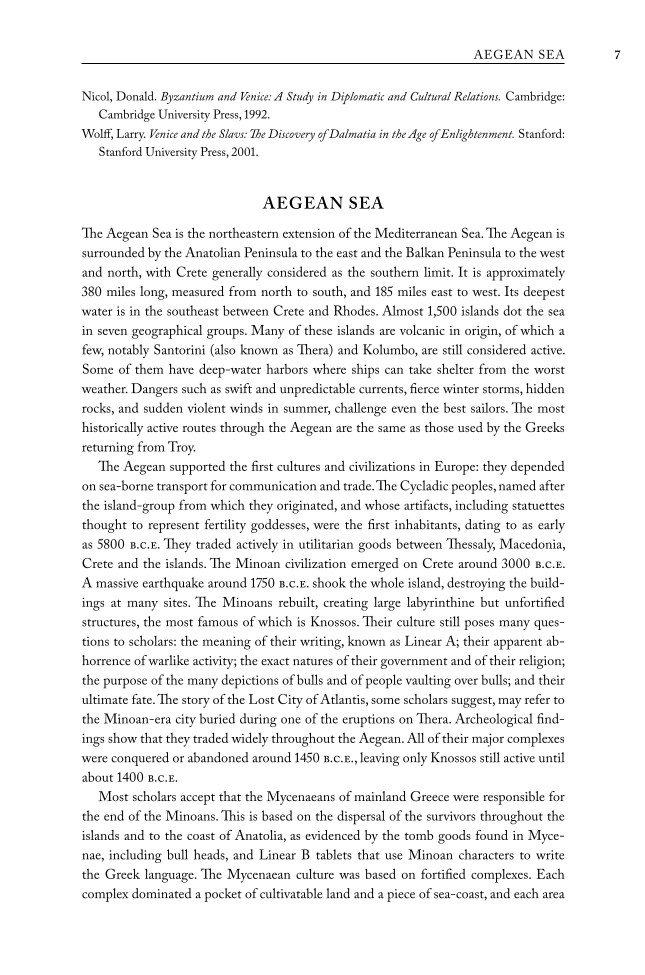AEGEAN SEA Nicol, Donald. Byzantium and Venice: A Study in Diplomatic and Cultural Relations. Cambridge: Cambridge University Press, . Wolff , Larry. Venice and the Slavs: Th e Discovery of Dalmatia in the Age of Enlightenment. Stanford: Stanford University Press, . AEGEAN SEA Th e Aegean Sea is the northeastern extension of the Mediterranean Sea. Th e Aegean is surrounded by the Anatolian Peninsula to the east and the Balkan Peninsula to the west and north, with Crete generally considered as the southern limit. It is approximately miles long, measured from north to south, and miles east to west. Its deepest water is in the southeast between Crete and Rhodes. Almost , islands dot the sea in seven geographical groups. Many of these islands are volcanic in origin, of which a few, notably Santorini (also known as Th era) and Kolumbo, are still considered active. Some of them have deep-water harbors where ships can take shelter from the worst weather. Dangers such as swift and unpredictable currents, fi erce winter storms, hidden rocks, and sudden violent winds in summer, challenge even the best sailors. Th e most historically active routes through the Aegean are the same as those used by the Greeks returning from Troy. Th e Aegean supported the fi rst cultures and civilizations in Europe: they depended on sea-borne transport for communication and trade. Th e Cycladic peoples, named after the island-group from which they originated, and whose artifacts, including statuettes thought to represent fertility goddesses, were the fi rst inhabitants, dating to as early as b.c.e. Th ey traded actively in utilitarian goods between Th essaly, Macedonia, Crete and the islands. Th e Minoan civilization emerged on Crete around b.c.e. A massive earthquake around b.c.e. shook the whole island, destroying the build- ings at many sites. Th e Minoans rebuilt, creating large labyrinthine but unfortifi ed structures, the most famous of which is Knossos. Th eir culture still poses many ques- tions to scholars: the meaning of their writing, known as Linear A their apparent ab- horrence of warlike activity the exact natures of their government and of their religion the purpose of the many depictions of bulls and of people vaulting over bulls and their ultimate fate. Th e story of the Lost City of Atlantis, some scholars suggest, may refer to the Minoan-era city buried during one of the eruptions on Th era. Archeological fi nd- ings show that they traded widely throughout the Aegean. All of their major complexes were conquered or abandoned around b.c.e. , leaving only Knossos still active until about b.c.e. Most scholars accept that the Mycenaeans of mainland Greece were responsible for the end of the Minoans. Th is is based on the dispersal of the survivors throughout the islands and to the coast of Anatolia, as evidenced by the tomb goods found in Myce- nae, including bull heads, and Linear B tablets that use Minoan characters to write the Greek language. Th e Mycenaean culture was based on fortifi ed complexes. Each complex dominated a pocket of cultivatable land and a piece of sea-coast, and each area
Document Details My Account Print multiple pages
Print
You have printed 0 times in the last 24 hours.
Your print count will reset on at .
You may print 0 more time(s) before then.
You may print a maximum of 0 pages at a time.
























































































































































































































































































































































































































































































































































































































































































































































































































